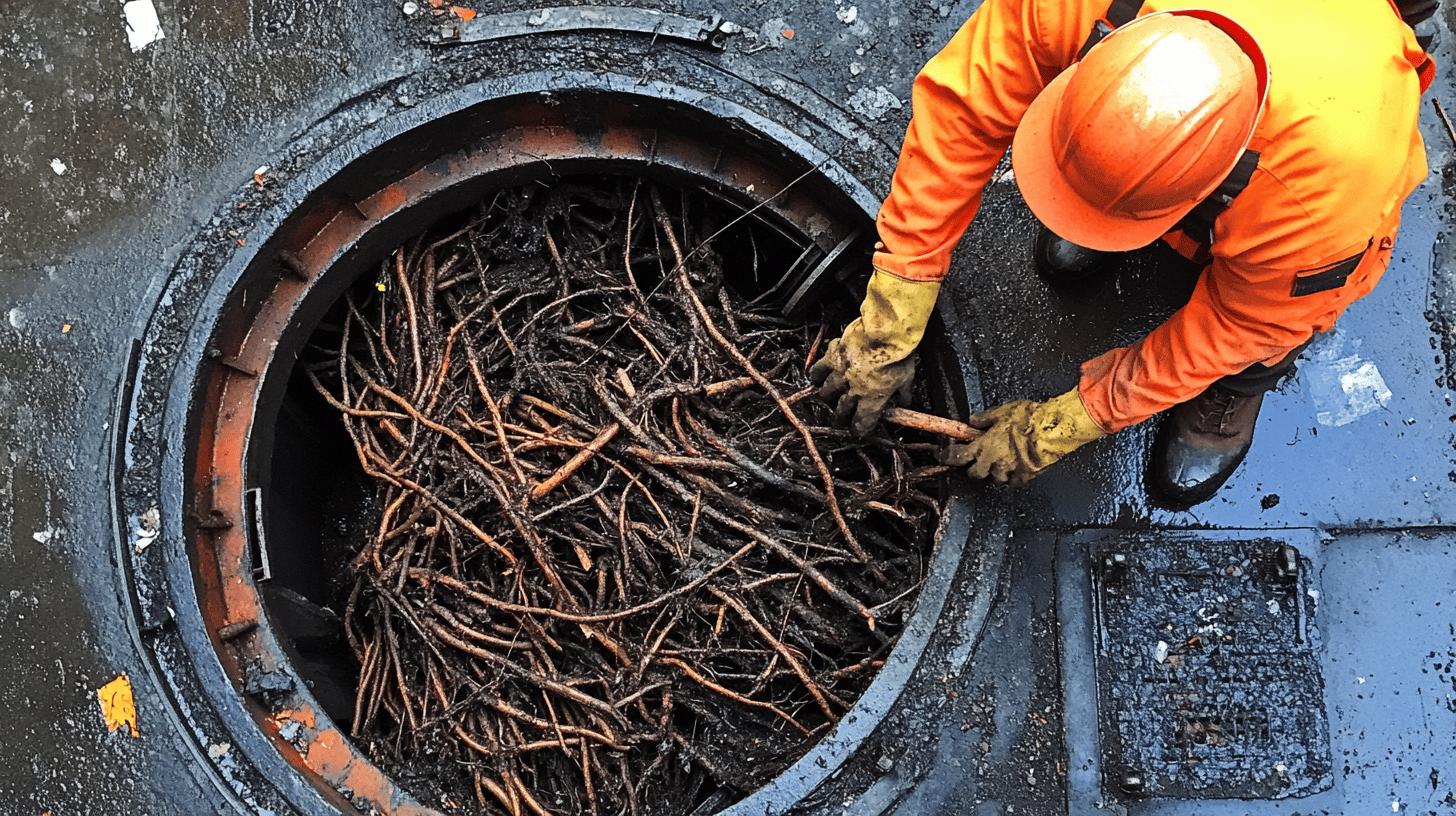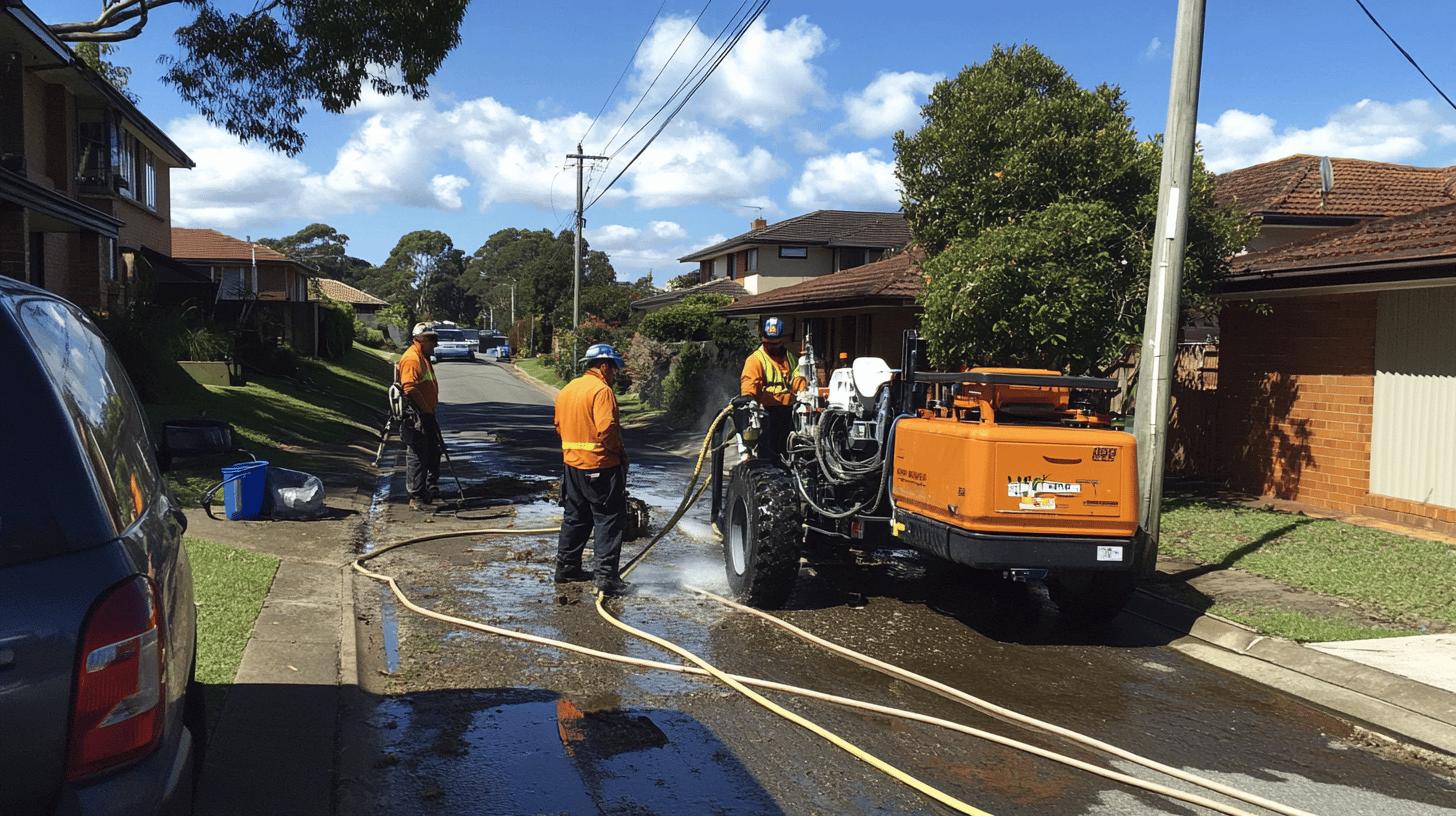TL;DR:
Sewer Blockage Symptoms:
- Backed-up/slow drains
- Strange smells or gurgling noises
- Standing sewage in the basement
Common Causes:
- Buildup of grease, hair, soap scum
- Tree root infiltration
- Flushing non-flushable items
DIY Solutions:
- Use a plunger, baking soda, vinegar
- Utilize a drain snake
- Rent a drain cleaner (follow safety protocols)
Professional Solutions:
- Hydro-jetting ($300-$500)
- Video Inspection ($100-$300)
- Trenchless Sewer Repair ($500-$800)
Prevention:
- Regular drain cleaning
- Avoid grease/non-flushable item disposal
- Use drain strainers and schedule annual inspections
Noticing weird smells or slow drains in your home? These could be serious signs of a sewer blockage. If you ignore them, you might end up facing major damage and costly repairs. Recognizing these signals is key to taking action and keeping your plumbing system healthy.
In this article, we’ll go over the common signs of a sewer blockage, how to spot them, and what steps you can take to prevent a plumbing disaster. Stay informed to keep your home safe from unexpected sewer problems!
Identifying Sewer Blockage Symptoms
Backed-up or slow drains are usually the first signs of a sewer blockage. If water is backing up in your toilets or sinks, there’s probably a blockage in the main sewer line, which affects multiple drains in your home. If only one drain is slow, it might be a smaller issue, but if several drains are slow, that’s a bigger problem that needs immediate attention.
Unusual smells and sounds from your drains can also indicate a blockage. If you notice sewage odors coming from sinks, bathtubs, or floor drains, it usually means waste is stuck and can’t flow. You might also hear gurgling noises, which happen when trapped air in the pipes tries to escape. Ignoring these signs could mean a serious obstruction in the main sewer line.
Seeing standing sewage in the basement or in the cleanout pipe is a clear warning of a major blockage. The main sewer line’s access point is usually in the yard or basement, and addressing standing sewage right away is crucial to prevent significant damage and health risks.
- Backed-up drains
- Slow drains
- Strange smells
- Gurgling noises
- Standing sewage
Common Causes of Sewer Blockages

Sewer blockages are often caused by the buildup of grease, hair, and soap scum. Over time, these materials combine to create a sticky mass that blocks water flow. Grease and fat solidify as they cool, sticking to the insides of pipes and trapping other debris. Hair and soap scum mix with this buildup to form larger clogs that usually require professional help to clear.
Another major culprit is tree roots. Roots are naturally drawn to moisture and nutrients, making sewer lines appealing. They can infiltrate small cracks in the pipes and expand, causing serious blockages. To prevent this, plant trees away from sewer lines or use root barriers. If roots do invade, you’ll likely need a professional to remove them.
Flushing non-flushable items like wet wipes or sanitary products can also cause major blockages. Unlike toilet paper, these items don’t break down in water, leading to solid masses that block wastewater flow and create backups. To prevent clogs, always dispose of non-flushable items in the trash, not the toilet.
- Buildup of grease, hair, and soap scum
- Tree roots infiltration
- Flushing non-flushable items
- Foreign objects in the sewer line
- Accumulation of fat and oils
DIY Solutions for Minor Sewer Blockages
For minor sewer blockages, a plunger is an easy tool to use. Ensure there’s enough water in the sink or toilet to cover the rubber part. Place it over the drain, create a seal, and use quick motions to generate suction. If the water drains slowly, the blockage is likely easing.
You can also try baking soda and vinegar. Pour one cup of baking soda followed by a cup of vinegar down the drain, let it sit for 15 minutes, then flush with boiling water. This eco-friendly method can help with stubborn clogs.
For tougher clogs, use a drain snake. Insert it until you hit resistance, rotate it to hook the blockage, and pull it out. If the problem persists, renting a drain cleaner might be necessary. Feed the cable into the cleanout and start the motor when you feel resistance. If the cable gets stuck, stop the machine, reverse a bit, and then go forward again. Always follow safety guidelines when using these tools.
- Wear gloves
- Ensure proper ventilation
- Avoid chemical drain cleaners
- Use appropriate tools
- Follow safety protocols
Professional Solutions for Severe Sewer Blockages

Hydro-jetting is a great way to tackle tough blockages in sewer lines. It uses high-pressure water jets to blast through debris, grease, and roots, ensuring a thorough cleaning that also prevents future clogs.
Video inspection cameras help plumbers diagnose severe blockages by allowing them to see inside the sewer line. This helps them choose the best fix, saving time and minimizing pipe damage.
Trenchless sewer repair is another option that involves minimal digging. One method is pipe lining, where a resin-coated liner is inflated inside the pipe, clearing blockages and making the sewer line stronger.
For serious blockages, hiring professional plumbers is essential. Their services typically range from $100 to $800 and ensure the problem is fixed properly, unlike DIY methods that may lead to more damage.
|Professional Method|Cost Range|
|——————-|———-|
|Hydro-jetting|$300 – $500|
|Video Inspection|$100 – $300|
|Trenchless Sewer Repair|$500 – $800|
|Roto-Rooter Services|$200 – $600|
Preventive Measures to Avoid Sewer Blockages
Regular drain cleaning is crucial to prevent sewer blockages caused by hair, soap scum, and food buildup. Simple methods like pouring boiling water or using a drain snake can help. Enzyme-based cleaners effectively break down organic materials without damaging pipes.
To avoid clogs, don’t pour grease or non-flushable items down the drain. Grease solidifies in pipes, while items like wet wipes don’t break down and cause blockages. Always dispose of grease in containers and toss non-flushable items in the trash. Using drain strainers can also catch hair and food.
Getting annual professional inspections is important for maintaining sewer lines. These check-ups can identify issues early, saving you from costly repairs. Pros use tools like video inspection cameras to spot hidden problems, keeping your sewer lines in good shape.
- Regularly clean drains
- Avoid disposing of grease
- Use drain strainers
- Schedule annual inspections
- Use enzyme-based cleaners
Final Words
Dealing with sewer blockages like slow drains or weird smells can be super annoying. We’ve talked about common causes like tree roots and flushing the wrong stuff, plus how to fix these issues on your own or with professional help.
If you spot the signs early and keep up with regular maintenance, you can avoid big problems and keep your plumbing working well. Remember, being proactive now can save you time, stress, and money later. Keep your sewer line healthy for a hassle-free home!
FAQ
How do I unclog my main sewer line?
Effective methods to unclog your main sewer line include using a plunger, a drain snake, or a combination of baking soda and vinegar followed by hot water. For severe blockages, professional assistance may be required.
How do I get rid of a sewage blockage?
To get rid of a sewage blockage, you can try using a plunger or a drain snake. If these methods are ineffective, consider hiring a professional plumber to use advanced tools like hydro-jetting.
How do I know if my sewer line is clogged?
Symptoms of a clogged sewer line include backed-up drains in toilets and sinks, slow-moving drains throughout the house, strange smells from drains, and standing sewage in the basement.
How do you unblock a clogged sewer?
You can unblock a clogged sewer using plungers, baking soda and vinegar followed by hot water, or a drain snake. For persistent clogs, professionals may use hydro-jetting or roto-rooter services.
How can I clear a main sewer line clog myself?
Clearing a main sewer line clog yourself involves using a plunger, drain snake, or a mix of baking soda and vinegar with hot water. Always wear gloves and ensure proper ventilation.
What causes sewer blockage?
Common causes of sewer blockages include the buildup of grease, hair, and soap scum, tree root infiltration, and flushing non-flushable items like wet wipes and sanitary products.
What are the symptoms of a sewer blockage?
Symptoms of a sewer blockage include backed-up drains, slow drains, strange smells, gurgling noises from drains, and standing sewage in the basement or sewer cleanout pipe.
Who is responsible for a blocked sewer drain?
Responsibility for a blocked sewer drain typically falls on the property owner. However, if the blockage is within the municipal sewer system, the local utility company may handle the repair.
How much does main sewer line clog repair cost?
Main sewer line clog repair costs generally range from $100 to $800, depending on the severity of the blockage and the method used for repair.
How do I prevent sewer line blockages?
Preventive measures include regularly cleaning drains, avoiding the disposal of grease and non-flushable items, using drain strainers, scheduling annual inspections, and using enzyme-based cleaners.

